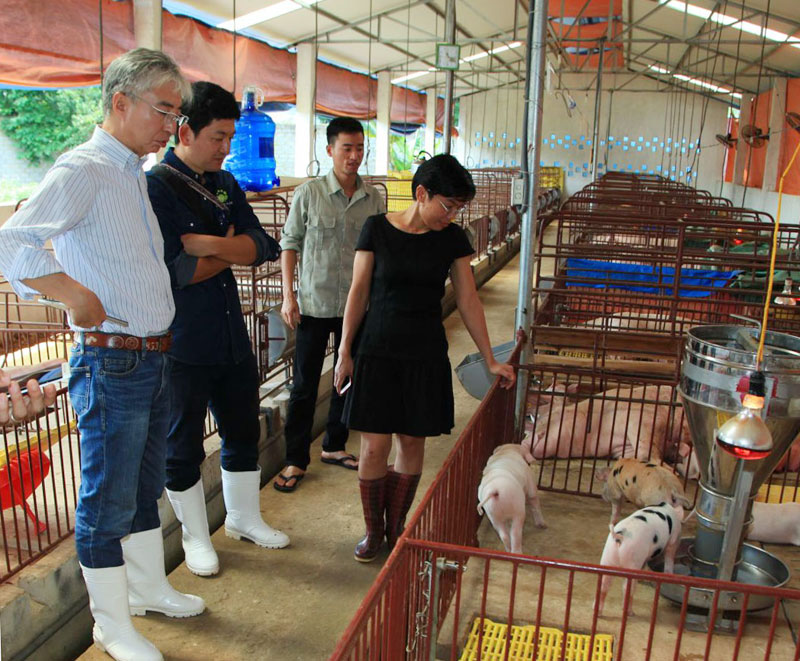
HBO - Suffering from serious health problem related to food, Bui Bich Lien from Dai Mo ward, Nam Tu Liem district (Hanoi) had a lot of concerns before deciding to choose Hoa Binh as a site to build Orfarm Thuy Thien Nhu (the cleanest farm model in Vietnam).
 Japanese experts visit
and laud farming model of Bui Bich Lien in Phu Thanh commune, Lac Thuy
district.
Japanese experts visit
and laud farming model of Bui Bich Lien in Phu Thanh commune, Lac Thuy
district.
She chose Phu Thanh to realise her idea. This place not only
meets criteria for the construction of a clean farm, but also sits in a convenient
location on Ho Chi Minh route. In 2013, Lien pooled all her money, including loans, to
invest in farming. In 2014, she started her own business with a clean farm
model named Thuy Thien Nhu.
Lien said documents on breeding and advanced Japanese effective
microorganism (EM) technology specially attracted and persuaded her. It is a
Japanese government-funded project in support of communities in over 100
countries. After contacting Japanese experts, she received their enthusiastic
support, from guiding the selection of strains, food processing, to building
farms.
On an area of over one ha at Thuy Thien Nhu
farm, Lien allocated about 3,000 sq.m for building an organic fruits and vegetables
zone with a variety of products, including leafy vegetables, eggplant,
cucumber, and tomato. Nearly one ha is used for pig and poultry breeding. She
developed a close-circuit farm model, adopted the Japanese EM technology in the
process of organic agricultural farming. As a result, the farm completely
controlled epidemic diseases, ensured that high quality organic agricultural
products meet "Three No" criteria, including no epidemics, no use of
plant protection medicine, no growth stimulus substance and other chemicals
that are toxic to human health and surrounding environment.
After 5 years, she has her own brand and become successful
in building the model "clean farm - green dining table." Consumers in
the country’s two largest cities of Hanoi and Ho Chi Minh city trust high-quality
and organic products of Hoa Binh origin, contributing to popularising farm
produce and attracting investment to local agricultural production.
According to data from the Hoa Binh Provincial Party Committee, the industrial production index for the first six months of 2025 is estimated to have increased by 20% compared to the same period last year. This marks the highest year-on-year growth rate for this period since 2020.
In the first six months of 2025, Hoa Binh province’s export turnover was estimated at 1.145 billion USD, marking an 18.11% increase compared to the same period in 2024. Import turnover was estimated at $ 804 million, a 17.15% increase, which helped the province maintain a positive trade balance.
The lives of the ethnic minority farmers in Tan Lac district have gradually improved thanks to the new directions in agricultural production. This is a testament to the collective strength fostered through the professional associations and groups implemented by various levels of the district’s Farmers’ Union.
With the motto the "product quality comes first,” after nearly one year of establishment and operation, Muong village’s Clean Food Agricultural and Commercial Cooperative, located in Cau Hamlet, Hung Son Commune (Kim Boi district), has launched reputable, high-quality agricultural products to the market that are well-received by consumers. The products such as Muong village’s pork sausage, salt-cured chicken, and salt-cured pork hocks have gradually carved out a place in the market and they are on the path to obtaining the OCOP certification.
In the past, the phrase "bumper harvest, rock-bottom prices" was a familiar refrain for Vietnamese farmers engaged in fragmented, small-scale agriculture. But today, a new spirit is emerging across rural areas of Hoa Binh province - one of collaboration, organisation, and collective economic models that provide a stable foundation for production.
Maintaining growing area codes and packing facility codes in accordance with regulations is a mandatory requirement for agricultural products to be eligible for export. Recently, the Department of Agriculture and Environment of Hoa Binh province has intensified technical supervision of designated farming areas and packing facilities to safeguard the "green passport" that enables its products to access international markets.



 Japanese experts visit
and laud farming model of Bui Bich Lien in Phu Thanh commune, Lac Thuy
district.
Japanese experts visit
and laud farming model of Bui Bich Lien in Phu Thanh commune, Lac Thuy
district.